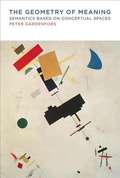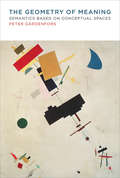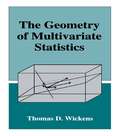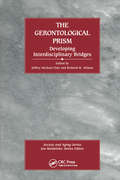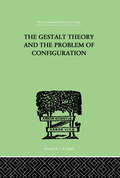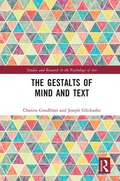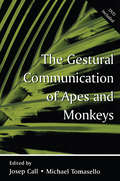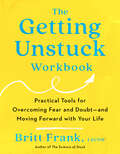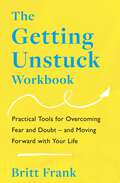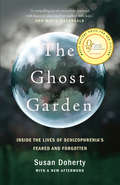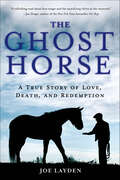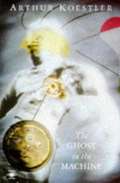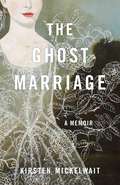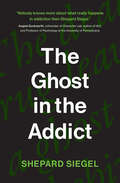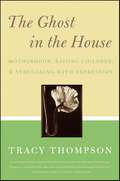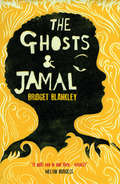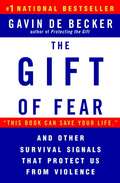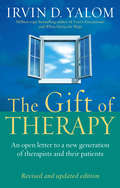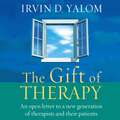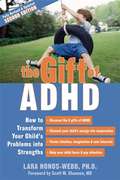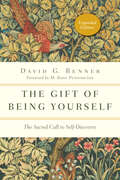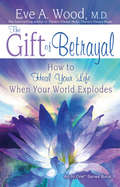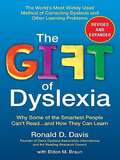- Table View
- List View
The Geometry of Meaning
by Peter GärdenforsIn The Geometry of Meaning, Peter Gärdenfors proposes a theory of semantics that bridges cognitive science and linguistics and shows how theories of cognitive processes, in particular concept formation, can be exploited in a general semantic model. He argues that our minds organize the information involved in communicative acts in a format that can be modeled in geometric or topological terms -- in what he terms conceptual spaces, extending the theory he presented in an earlier book by that name. Many semantic theories consider the meanings of words as relatively stable and independent of the communicative context. Gärdenfors focuses instead on how various forms of communication establish a system of meanings that becomes shared between interlocutors. He argues that these "meetings of mind" depend on the underlying geometric structures, and that these structures facilitate language learning. Turning to lexical semantics, Gärdenfors argues that a unified theory of word meaning can be developed by using conceptual spaces. He shows that the meaning of different word classes can be given a cognitive grounding, and offers semantic analyses of nouns, adjectives, verbs, and prepositions. He also presents models of how the meanings of words are composed to form new meanings and of the basic semantic role of sentences. Finally, he considers the future implications of his theory for robot semantics and the Semantic Web.
The Geometry of Meaning: Semantics Based on Conceptual Spaces
by Peter GardenforsA novel cognitive theory of semantics that proposes that the meanings of words can be described in terms of geometric structures. In The Geometry of Meaning, Peter Gärdenfors proposes a theory of semantics that bridges cognitive science and linguistics and shows how theories of cognitive processes, in particular concept formation, can be exploited in a general semantic model. He argues that our minds organize the information involved in communicative acts in a format that can be modeled in geometric or topological terms—in what he terms conceptual spaces, extending the theory he presented in an earlier book by that name. Many semantic theories consider the meanings of words as relatively stable and independent of the communicative context. Gärdenfors focuses instead on how various forms of communication establish a system of meanings that becomes shared between interlocutors. He argues that these “meetings of mind” depend on the underlying geometric structures, and that these structures facilitate language learning. Turning to lexical semantics, Gärdenfors argues that a unified theory of word meaning can be developed by using conceptual spaces. He shows that the meaning of different word classes can be given a cognitive grounding, and offers semantic analyses of nouns, adjectives, verbs, and prepositions. He also presents models of how the meanings of words are composed to form new meanings and of the basic semantic role of sentences. Finally, he considers the future implications of his theory for robot semantics and the Semantic Web.
The Geometry of Multivariate Statistics
by Thomas D. WickensA traditional approach to developing multivariate statistical theory is algebraic. Sets of observations are represented by matrices, linear combinations are formed from these matrices by multiplying them by coefficient matrices, and useful statistics are found by imposing various criteria of optimization on these combinations. Matrix algebra is the vehicle for these calculations. A second approach is computational. Since many users find that they do not need to know the mathematical basis of the techniques as long as they have a way to transform data into results, the computation can be done by a package of computer programs that somebody else has written. An approach from this perspective emphasizes how the computer packages are used, and is usually coupled with rules that allow one to extract the most important numbers from the output and interpret them. Useful as both approaches are--particularly when combined--they can overlook an important aspect of multivariate analysis. To apply it correctly, one needs a way to conceptualize the multivariate relationships that exist among variables. This book is designed to help the reader develop a way of thinking about multivariate statistics, as well as to understand in a broader and more intuitive sense what the procedures do and how their results are interpreted. Presenting important procedures of multivariate statistical theory geometrically, the author hopes that this emphasis on the geometry will give the reader a coherent picture into which all the multivariate techniques fit.
The Gerontological Prism: Developing Interdisciplinary Bridges (Society and Aging Series)
by Jeffrey Michael Clair Richard Allman"The Gerontological Prism" promotes disciplinary cooperation in aging research and practice. To some extent, each chapter explores a unified objective, that of generating a disciplinary-blind gerontology. The fundamental assumption throughout this book is that the aging individual and society can be enhanced by an understanding of the correlates of basic social, behavioral, demographic, economic, political, ethical, and biomedical processes involving aging. Each author touches on issues that have both social psychological, and practical policy significance. They aim toward sensitizing the reader to the possibilities of a properly informed interdisciplinary approach to gerontology.
The Gestalt Approach, and Eye Witness to Therapy
by Fritz PerlsThe Gestalt Approach is "an exploration of a somewhat new approach to the entire subject of human behavior -- both in its actuality and its potentiality." Eye Witness contains film transcripts that Perls believed had significant teaching value.
The Gestalt Theory And The Problem Of Configuration (International Library Of Psychology Ser.)
by Bruno PetermannThis is Volume VIII of a series of twenty-one on Cognitive Psychology. Originally published in 1932, this study looks at the problem of configuration and the Gestalt Theory, its empirical foundation and dynamics.
The Gestalts of Mind and Text (Studies and Research in the Psychology of Art)
by Chanita Goodblatt Joseph GlicksohnThe Gestalts of Mind and Text bridges literary studies and cognitive psychology to provide a unique contribution to the field of Cognitive Literary Studies. The book presents an investigation of metaphor in poetic texts, adopting and developing empirical methods used by Gestalt Psychology, while integrating concepts informed by Gestalt Psychology. The title indicates an intellectual tradition, to be termed the Gestalt of the Mind, that begins with the Würzburg School of Psychology and its subsequent development into Gestalt Psychology, which provides a rich heritage for the field of Cognitive Literary Studies. The title further indicates an intellectual and creative tradition, to be termed the Gestalt of the Text, applied to various literary schools (Medieval, Early Modern, Modernist). Finally, the Gestalt-Interaction Theory of Metaphor delineates the potentialities for different types of readings of poetic metaphor. This book further makes three significant contributions: the first is the focus on the empirical investigation of metaphor in poetic texts; the second is the integration of the aspects of problem-solving, bidirectionality of metaphor, embodied cognition and the grotesque, in analyzing poetic texts and verbal protocols; and the third is the focus on various literary traditions, spanning languages and periods. The goal of this book is to present an interdisciplinary study of the Gestalts of Mind and Text. This will be of interest to a varied audience, including cognitive psychologists, literary scholars, researchers in aesthetics, scholars of metaphor and those with an interest in intellectual history.
The Gestural Communication of Apes and Monkeys
by Josep Call; Michael TomaselloThe Gestural Communication of Apes and Monkeys is an intriguing compilation of naturalistic and experimental research conducted over the course of 20 years on gestural communication in primates, as well as a comparison to what is known about the vocal communication of nonhuman primates. The editors also make systematic comparisons to the gestural communication of prelinguistic and just-linguistic human children. An enlightening exploration unfolds into what may represent the starting point for the evolution of human communication and language. This especially significant read is organized into nine chapters that discuss:*the gestural repertoire of chimpanzees;*gestures in orangutans, subadult gorillas, and siamangs;*gestural communication in Barbary macaques; and*a comparison of the gestures of apes and monkeys. This book will appeal to psychologists, anthropologists, and linguists interested in the evolutionary origins of language and/or gestures, as well as to all primatologists. A CD insert offers video of gestures for each of the species.
The Getting Unstuck Workbook: Practical Tools for Overcoming Fear and Doubt - and Moving Forward with Your Life
by Britt FrankExercises and activities to help you move past what&’s holding you back, in work and lifeYou want to get fit, but you keep putting it off. Your career is stalled out, and you&’re not sure how to give it a jump. You fall into the same unhealthy relationship patterns over and over. If you&’ve been in any of these scenarios, you know what it means to be stuck—but you don&’t have to stay that way. You&’re not lazy and you&’re not unmotivated. You just need the right set of tools. And Britt Frank uses her background as a clinician, educator, and trauma specialist to bring you a whole new tool kit with this interactive workbook. Inside you&’ll find questionnaires, writing prompts, and other practical, step-by-step exercises to help you:break bad habitscommunicate more skillfully stop the war in your headhold healthy boundariesrestore your sense of choice Take control of your actions and the life you want to live with The Getting Unstuck Workbook.
The Getting Unstuck Workbook: Practical Tools for Overcoming Fear and Doubt – and Moving Forward with Your Life (The Science of Stuck)
by Britt FrankExercises and activities to help you move past what's holding you back, in work and life.You want to get fit, but you keep putting it off. Your career is stalled out, and you're not sure how to give it a jump. You fall into the same unhealthy relationship patterns over and over. If you've been in any of these scenarios, you know what it means to be stuck-but you don't have to stay that way.You're not lazy and you're not unmotivated. You just need the right set of tools. And Britt Frank uses her background as a clinician, educator, and trauma specialist to bring you a whole new tool kit with this interactive workbook. Inside you'll find questionnaires, writing prompts, and other practical, step-by-step exercises to help you:-break bad habits-communicate more skillfully-stop the war in your head-hold healthy boundaries-restore your sense of choiceTake control of your actions and the life you want to live with The Getting Unstuck Workbook.
The Ghost Chronicles
by Maureen Wood Ron KolexJourney into a world of the unexplained and the unknown, a world where what you can't see captivates all your attention. A trance medium and a paranormal scientist team up in this spellbinding collection of 17 supernatural mysteries, a mere sampling of the spooky episodes in their vast ghost hunting case files.
The Ghost Garden: Inside the lives of schizophrenia's feared and forgotten
by Susan DohertyA rare work of narrative non-fiction that illuminates a world most of us try not to see: the daily lives of the severely mentally ill, who are medicated, marginalized, locked away and shunned.Susan Doherty's groundbreaking book brings us a population of lost souls, ill-served by society, feared, shunted from locked wards to rooming houses to the streets to jail and back again. For the past ten years, some of the people who cycle in and out of the severely ill wards of the Douglas Institute in Montreal, have found a friend in Susan, who volunteers on the ward, and then follows her friends out into the world as they struggle to get through their days. With their full cooperation, she brings us their stories, which challenge the ways we think about people with mental illness on every page. The spine of the book is the life of Caroline Evans (not her real name), a woman in her early sixties whom Susan has known since she was a bright and sunny school girl. Caroline had formed a close friendship with Susan and shared stories from her life; through her, we experience what living with schizophrenia over time is really like. She has been through it all, including the way the justice system treats the severely mentally ill: at one point, she believed that she could save her roommate from the devil by pouring boiling water into her ear... Susan interleaves Caroline's story with vignettes about her other friends, human stories that reveal their hopes, their circumstances, their personalities, their humanity. She's found that if she can hang in through the first ten to fifteen minutes of every coffee date with someone in the grip of psychosis, then true communication results. Their "madness" is not otherworldly: instead it tells us something about how they're surviving their lives and what they've been through. The Ghost Garden is not only touching, but carries a cargo of compassion and empathy.
The Ghost Horse: A True Story of Love, Death, and Redemption
by Joe Layden“A rollicking read about how magic and the mystifying thrive at the racetrack” from the New York Times–bestselling author (Joe Drape, author of The Saint Makers).In The Ghost Horse, Joe Layden tells the inspiring true tale of a one-eyed, club-footed thoroughbred racehorse and a journeyman trainer, Tim Snyder, who scraped together every penny he had to purchase the broken and unwanted filly.Snyder helped the horse overcome its deficiencies, eventually naming her in part after his deceased wife, Lisa, the great and only love of his life—a bright and sweet-tempered woman whose gentle demeanor seemed eerily reflected in the horse. The trainer (and now owner) was by nature a crusty and combative sort, the yin to his wife’s yang, a racetrack lifer not easily moved by new-age mysticism or sentiment. And yet in those final days back in 2003, when Lisa Snyder lay in bed, her body ravaged by cancer, she reassured her family with a weak smile. “It’s okay,” she’d say. “I’ll see you again. I’m coming back as a horse.”Tim Snyder did not then believe in reincarnation. But he acknowledged the strangeness of this journey, the series of coincidences that brought them together, and the undeniable similarities between the horse and his late wife. And so did those who knew the couple well, and who could now only marvel at the story of the filly, Lisa’s Booby Trap, and the down-on-his-luck trainer who apparently had been given a new lease on life.The Ghost Horse is a powerful horseracing story of underdogs and second chances.“A heart-warming tale, artfully told.” —William Nack, author of Secretariat
The Ghost In The Machine
by Arthur Koestlerfrom the book's back cover: In The Sleepwalkers and The Act of Creation Arthur Koestler provided pioneering studies of scientific discovery and artistic inspiration, the twin pinnacles of human achievement. The Ghost in the Machine looks at the dark side of the coin: our terrible urge to self-destruction... Could the human species be a gigantic evolutionary mistake? To answer that startling question Koestler examines how experts on evolution and psychology all too often write about people with an 'antiquated slot-machine model based on the naively mechanistic world-view of the nineteenth century'. His brilliant polemic helped to instigate a major revolution in the life sciences, yet its 'glimpses of an alternative world-view' form only the background to an even more challenging analysis of the human predicament. Perhaps, he suggests, we are a species in which ancient and recent brain structures - or reason and emotion -- are not fully co-ordinated. Such in-built deficiencies may explain the paranoia, violence and insanity that are central strands of human history. And however disturbing we find such issues, Koestler contends, it is only when we face our limitations head-on that we can hope to find a remedy.
The Ghost Marriage: A Memoir
by Kirsten MickelwaitAt thirty-one, Kirsten has just returned to San Francisco from a bohemian year in Rome, ready to pursue a serious career as a writer and eventually, she hopes, marriage and family. When she meets Steve Beckwith, a handsome and successful attorney, she begins to see that future materialize more quickly than she&’d dared to expect. Twenty-two years later, Steve has turned into someone quite different. Unemployed and addicted to opioids, he uses money and their two children to emotionally blackmail Kirsten. What&’s more, he&’s been having an affair with their real estate agent, who is also her close friend. So she divorces him—but after their divorce is finalized, Steve is diagnosed with colon cancer and dies within a year, leaving Kirsten with $1.5 million in debts she knew nothing about. It&’s then that she finally understands: The man she&’d married was a needy, addictive person who came wrapped in a shiny package.As she fights toward recovery, Kirsten begins to receive communications from Steve in the afterlife—which lead her on an unexpected path to forgiveness. The Ghost Marriage is her story of discovery—that life isn&’t limited to the tangible reality we experience on this earth, and that our worst adversaries can become our greatest teachers.
The Ghost in the Addict
by Shepard SiegelHow withdrawal distress and cravings can haunt current and former addicts, and what they can teach us about addiction and its treatments.&“The dead drug leaves a ghost behind. At certain hours it haunts the house,&” Jean Cocteau once wrote. In The Ghost in the Addict, Shepard Siegel offers a Pavlovian analysis of drug use. Chronic drug use, he explains, conditions users to have an anticipatory homeostatic correction, which protects the addict from overdose. This drug-preparatory response, elicited by drug-paired cues, is often mislabeled a &“withdrawal response.&” The withdrawal response, however, is not due to the baneful effects of previous drug administrations; rather, it is due to the body&’s preparation for the next drug administration—a preparatory response that can haunt addicts like a ghost long after they have conquered their usage.Examining the failure of legislation, the circumstances of overdose, and the cues that promote drug use, Siegel seeks to counter the widespread belief that addiction is evidence of a pathology. Instead, he proposes that the addict has an adaptive, learned response to the physiological changes wrought by drug use. It is only through understanding so-called withdrawal symptoms as a Pavlovian response, he explains, that we can begin to understand why addicts experience cravings long after their last drug use.
The Ghost in the House: Motherhood, Raising Children, & Struggling with Depression
by Tracy ThompsonAn award-winning reporter for the Washington Post, Tracy Thompson was thirty-four when she was hospitalized and put on suicide watch during a major depressive episode. This event, the culmination of more than twenty years of silent suffering, became the point of departure for an in-depth, groundbreaking book on depression and her struggle with the disease. The Beast shattered stereotypes and inspired countless readers to confront their own battles with mental illness. Having written that book, and having found the security of a happy marriage, Thompson assumed that she had learned to manage her illness. But when she took on one of the most emotionally demanding jobs of all—being a mother—depression returned with fresh vengeance.Very quickly Thompson realized that virtually everything she had learned up to then about dealing with depression was now either inadequate or useless. In fact, maternal depression was a different beast altogether. She tackled her problem head-on, meticulously investigating the latest scientific research and collecting the stories of nearly 400 mothers with depression. What she found was startling: a problem more widespread than she or any other mother struggling alone with this affliction could have imagined. Women make up nearly 12 million of the 19 million Americans affected by depression every year, experiencing episodes at nearly twice the rate that men do. Women suffer most frequently between the ages of twenty-five and forty-four—not coincidentally, the primary childbearing years.The Ghost in the House, the result of Thompson's extensive studies, is the first book to address maternal depression as a lifelong illness that can have profound ramifications for mother and child. A striking blend of memoir and journalism, here is an invaluable resource for the millions of women who are white-knuckling their way through what should be the most satisfying years of their lives. Thompson offers her readers a concise summary of the cutting-edge research in this field, deftly written prose, and, above all, hope.
The Ghosts & Jamal
by Bridget BlankleyA heroic journey made by a boy who wasn't born to be a hero. Waking up in the aftermath of a terrorist attack, 13-year-old Jamal sets out to find out why the rules he grew up with no longer apply and how he fits into the new world that he finds himself in. The Ghosts & Jamal is an original and compelling novel, exploring prejudice and exploitation as well as friendship and hope. Faith, violence, and societal attitudes towards disability form a thought-provoking backdrop to this story of immense bravery, exploring how we face our fears as we learn to do what is right. Jamal holds up a mirror to violence-driven societies everywhere. While trying to evade capture by his attackers, Jamal tries to piece together what has happened. Will he survive his quest to find out who or what is responsible for the death of his family?
The Gift Of Fear: And Other Survival Signals That Protect Us From Violence
by Gavin De BeckerTrue fear is a gift. Unwarranted fear is a curse. Learn how to tell the difference. <p><p> A date won't take "no" for an answer. The new nanny gives a mother an uneasy feeling. A stranger in a deserted parking lot offers unsolicited help. The threat of violence surrounds us every day. But we can protect ourselves, by learning to trust—and act on—our gut instincts. <p> In this empowering book, Gavin de Becker, the man Oprah Winfrey calls the nation's leading expert on violent behavior, shows you how to spot even subtle signs of danger—before it's too late. Shattering the myth that most violent acts are unpredictable, de Becker, whose clients include top Hollywood stars and government agencies, offers specific ways to protect yourself and those you love, including...how to act when approached by a stranger...when you should fear someone close to you...what to do if you are being stalked...how to uncover the source of anonymous threats or phone calls...the biggest mistake you can make with a threatening person...and more. Learn to spot the danger signals others miss. It might just save your life.
The Gift Of Therapy (Revised And Updated Edition): An open letter to a new generation of therapists and their patients
by Irvin YalomTHE GIFT OF THERAPY is the culmination of master psychiatrist Dr Irvin Yalom's thirty-five years' work as a therapist, illustrating through real case studies how patients and therapists alike can get the most out of therapy. Presented as eighty-five 'tips' for 'beginner therapists', Yalom shares his own fresh approach and the insights he has gained while treating his patients. Personal, and sometimes provocative, Yalom makes some unorthodox suggestions, including: Let the patient matter to you; Acknowledge your errors; Create a new therapy for each patient; Make home visits; (Almost) never make decisions for a patient; and Freud was not always wrong. This is an entertaining, informative and insightful read for both beginners and more experienced therapists, patients, students and everyone with an interest in the subject.
The Gift Of Therapy: An open letter to a new generation of therapists and their patients
by Irvin YalomAcclaimed author and renowned psychiatrist Irvin D. Yalom distills thirty-five years of psychotherapy wisdom into one brilliant volume.The culmination of master psychiatrist Dr. Irvin D. Yalom's more than thirty-five years in clinical practice, The Gift of Therapy is a remarkable and essential guidebook that illustrates through real case studies how patients and therapists alike can get the most out of therapy. The bestselling author of Love's Executioner shares his uniquely fresh approach and the valuable insights he has gained-presented as eighty-five personal and provocative 'tips for beginner therapists', including:*Let the patient matter to you*Acknowledge your errors*Create a new therapy for each patient*Do home visits*(Almost) never make decisions for the patient*Freud was not always wrongA book aimed at enriching the therapeutic process for a new generation of patients and counsellors, Yalom's Gift of Therapy is an entertaining, informative, and insightful read for anyone with an interest in the subject.
The Gift of ADHD: How to Transform Your Child's Problems into Strengths (Second Edition)
by Lara Honos-WebbThis second edition of The Gift of ADHD includes compelling new research indicating that the impulses that lead your child to act exuberantly may correspond with unusual levels of creativity and a heightened capacity for insight into the feelings and emotions of others. <P><P>Lara Honos-Webb presents the evidence for this revolutionary concept and explains how you can help your child develop control over inattentive, hyperactive behavior and enhance the five gifts of ADHD: creativity, attunement to nature, interpersonal intuition, energetic enthusiasm, and emotional sensitivity. <P><P>Filled with easy skill-building activities you and your child can do together, this book will help your child transform problematic symptoms into strengths, then build the self-esteem they need to let those gifts shine.
The Gift of Being Yourself: The Sacred Call to Self-Discovery (The Spiritual Journey)
by David G. Benner"Grant, Lord, that I may know myself that I may know thee." —Augustine Much is said in Christian circles about knowing God. But Christians throughout the ages have agreed that there cannot be deep knowledge of God without deep knowledge of the self. Discerning your true self is inextricably related to discerning God's purposes for you. Paradoxically, the more you become like Christ, the more you become authentically yourself. In this profound exploration of Christian identity, psychologist and spiritual director David G. Benner illuminates the spirituality of self-discovery. He exposes the false selves that you may hide behind and calls you to discover the true self that emerges from your uniqueness in Christ. Freeing you from illusions about yourself, Benner shows that self-understanding leads to the fulfillment of your God-given destiny and vocation. Rest assured, you need not try to be someone you are not. But you will deepen your experience of God through discovering the gift of being yourself. This expanded edition, one of three titles in The Spiritual Journey trilogy, includes a new epilogue and an experiential guide with questions for individual reflection or group discussion.
The Gift of Betrayal: How To Heal Your Life When Your World Explodes
by Eve A. WoodYou’ve been betrayed by a loved one. But, you are not alone. Join esteemed psychiatrist, relationship expert and prolific author, Eve A. Wood, M.D., in this life altering workshop. Learn how to heal your life after this horrendous experience. What feels like a curse is really a blessing in disguise. Eve ought to know. She’s been there herself. And she’s helped hundreds of others heal their lives after gut-wrenching betrayals. You too can climb out of the pit of despair and live your heart’s desire. But you need to know how to do it. In this workshop, based on Eve’s most recent book, The Gift of Betrayal, you will: - Learn and practice the 14 key lessons to heal your life - Take a series of specific action steps to create your heart’s desire - Develop a personal transformation mission statement for continued self-healing at home. Discover the roles of anger, blame, forgiveness, personal history, mindset, friendship, attitude, belief, spirituality, sexuality, passion, hope, and faith in healing. Draw on sharing exercises, reflective techniques, guided imagery, writing, and cognitive, and behavioral interventions to find your own unique path to wholeness and joy. You can create a glorious future. You will be successful!
The Gift of Dyslexia, Revised and Expanded
by Davis Ronald D.The revised, updated, and expanded edition of the classic in the category. This book outlines a unique and revolutionary program with a phenomenally high success rate in helping dyslexics learn to read and to overcome other difficulties associated with it. This new edition is expanded to include new teaching techniques and revised throughout with up-to-date information on research, studies, and contacts.
